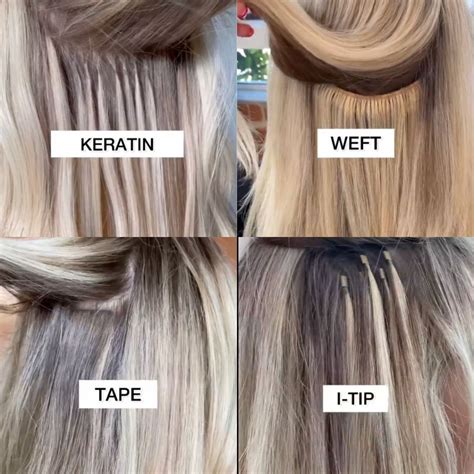Hair extensions are a versatile way to instantly transform your look, add length and volume, or experiment with different hair colors without damaging your natural locks. From subtle highlights to bold ombré effects, the possibilities for hair color with extensions are endless.

Stats and Figures
- According to a study by the American Hairdressing Council, over 50% of women use hair extensions at least once in their lifetime.
- The global hair extension market is projected to reach $12.5 billion by 2027, with clip-in extensions accounting for the largest share.
- Extensions can last anywhere from 4 to 12 weeks, depending on the type and care.
Before choosing a hair color for your extensions, it’s important to consider the different types available:
- Clip-ins: Temporary extensions that can be easily clipped into and out of your hair.
- Tape-ins: Bonded to your hair using double-sided tape.
- Fusion: Strands of hair that are attached to your natural hair using heat or glue.
- Weaves: Strands of hair that are sewn into your natural hair using a weft.
The key to choosing the right hair color for extensions is to match it to your natural hair as closely as possible. Consider the following factors:
- Base color: Determine the dominant color of your natural hair.
- Highlights or lowlights: If you have any natural highlights or lowlights, try to match the tone and placement.
- Skin tone: Hair color should complement your skin tone. Consider your undertones (warm, cool, or neutral).
1. Ombré
- Blends two or more shades of hair color, creating a gradual transition.
- Popular shades include brown to blonde, black to blue, and red to orange.
- Can add depth, dimension, and length to your hair.
2. Balayage
- A freehand painting technique that mimics the natural highlights that the sun creates.
- Creates a more natural, blended look than traditional highlights.
- Ideal for adding dimension to dark hair or creating a subtle blonde ombré.
3. Dip Dye
- Involves dipping the bottom portion of your hair into a different color.
- A bold and edgy way to add a splash of color to your look.
- Can be done with any color combination, from pastels to vibrant neons.
4. Highlights
- Adding streaks of lighter color to your natural hair.
- Can brighten your look, add volume, and frame your face.
- Available in a wide range of shades, from blonde to red to blue.
5. Lowlights
- Adding streaks of darker color to your natural hair.
- Can add depth, richness, and contrast to your look.
- Ideal for creating a more dimensional, multi-tonal effect.
1. Consultation: Consult with a hairstylist to determine the best type of extensions and hair color for your desired look.
2. Preparation: Wash and condition your hair before applying the extensions. Detangle and blow dry your hair if needed.
3. Application: The specific application method will vary depending on the type of extensions you choose.
4. Coloration: Once the extensions are applied, your hairstylist will color them to match your natural hair.
5. Maintenance: Follow the instructions provided by your hairstylist for proper care and maintenance of your hair extensions.
- Use a color-protecting shampoo and conditioner to prevent fading.
- Avoid using heat styling tools at high temperatures.
- Brush and style your hair gently to avoid damaging the extensions.
- Get regular trims to remove any split ends.
- Consider using hair masks or treatments to keep your extensions healthy and hydrated.
Pros:
- Can instantly transform your look.
- Add length, volume, or color to your hair.
- Protect your natural hair from damage.
- Can be removed or changed easily.
Cons:
- Can be expensive.
- May require professional application.
- Can damage your natural hair if not applied or cared for properly.
1. Vibrant Hues: Experiment with bold colors like blue, purple, or green to create a head-turning look.
2. Pastel Shades: Add a touch of whimsy with soft pastel hues like pink, blue, or lavender.
3. Metallic Accents: Incorporate metallic tones like silver or gold for a glamorous effect.
4. Rainbow Extensions: Create a vibrant and colorful masterpiece by using multiple shades of hair color in different sections of your hair.
5. Root Color: Color the roots of your extensions to blend them seamlessly with your natural hair and achieve a more natural look.
| Hair Color | Extension Type | Look |
|---|---|---|
| Platinum Blonde | Tape-ins | Bold and glamorous |
| Strawberry Blonde | Balayage | Warm and flattering |
| Raven Black | Fusion | Edgy and mysterious |
| Caramel Brown | Ombré | Natural and dimensional |
| Burgundy | Dip Dye | Rich and sophisticated |
| Hair Color | Skin Tone | Best Shades |
|---|---|---|
| Cool | Fair | Platinum blonde, ash brown, silver |
| Warm | Medium | Golden blonde, honey brown, copper |
| Neutral | Olive | Caramel brown, chocolate brown, auburn |
| Extension Type | Pros | Cons |
|---|---|---|
| Clip-ins | Easy to apply and remove, can be reused | May not last as long as other types |
| Tape-ins | Less damaging than fusion, can be blended well | May show with improper application |
| Fusion | Long-lasting, can create a seamless look | Can damage hair if not applied properly |
| Weaves | Versatile, can be used to add volume and length | May take a long time to install |
| Hair Care Tips | Description |
|---|---|
| Use a color-protecting shampoo and conditioner | Protects hair from fading |
| Avoid heat styling tools at high temperatures | Prevents damage to extensions |
| Brush and style hair gently | Prevents tangles and breakage |
| Get regular trims | Removes split ends and keeps extensions healthy |
| Use hair masks or treatments | Moisturizes and nourishes extensions |
